Biotransformation of Chromium (VI) via a Reductant Activity from the Fungal Strain Purpureocillium lilacinum
Abstract
:1. Introduction
2. Materials and Methods
2.1. Fungus Isolation and Culture Conditions
2.2. Morphological and Phylogenetic Identification of the Fungal Strain
2.3. Preparation of Cell Free Extracts (CFE)
2.4. Partial Characterization of Reductant Activity
2.5. Reductant Activity Assay and Protein Determination
2.6. Characterization of Cell Fractions by Fourier-Transform Infrared (FTIR) Spectroscopy
3. Results and Discussion
3.1. Molecular Characterization of the Fungal Strain
3.2. Localization of Reductant Activity
3.3. Effect of pH on Reductant Activity
3.4. Effect of Temperature on the Reductant Activity
3.5. Effect of Initial Chromium Concentration on Crude Reductant Activity
3.6. Effect of Different Metal Cations on the Crude Reductant Activity
3.7. Effect of Different Inhibitors on the Crude Reductant Activity
3.8. Effect of Different Carbon Sources as Electron Donors on the Crude Reductant Activity
3.9. Effect of Different Concentration of Protein on the Reductant Activity
3.10. Effect of Cr (VI) on IR Region of the Subcellular Fraction
3.11. Biotransformation of Cr (VI) to Cr (III)
4. Conclusions
Author Contributions
Funding
Institutional Review Board Statement
Informed Consent Statement
Data Availability Statement
Acknowledgments
Conflicts of Interest
References
- Cheung, K.H.; Gu, J.D. Mechanism of hexavalent chromium detoxification by microorganisms and bioremediation application potential: A review. Int. Biodeterior. Biodegrad. 2007, 59, 8–15. [Google Scholar] [CrossRef]
- Bielicka, A.; Bojanowska, I.; Wisniewski, A. Two Faces of Chromium-pollutant and bioelement. Polish. J. Environ. Study 2005, 14, 5–10. [Google Scholar]
- Quievryn, G.; Peterson, E.; Messer, J.; Zhitkovicha, A. Genotoxicity and mutagenicity of chromium (VI)/ascorbate-generated DNA adducts in humans and bacterial cells. Biochem 2003, 42, 1062–1070. [Google Scholar] [CrossRef] [PubMed]
- Mordenti, A.; Piva, G. Chromium in animal nutrition and possible effects on human health. In Chromium Environmental Issues; Canali, S., Tittarelli, F., Sequi, P., Eds.; Franco-Angeli Editore: Milan, Italy, 1997; pp. 131–151. [Google Scholar]
- Barrera-Díaz, C.E.; Lugo-Lugo, V.; Bilyeu, B. A review of chemical, electrochemical, and biological methods for aqueous Cr (VI) reduction. J. Hazard. Mater. 2012, 223, 1–12. [Google Scholar] [CrossRef] [PubMed]
- Cossich, E.S.; Tavares, C.R.G.; Ravagnani, T.M.K. Biosorption of chromium (III) by Sargassum sp. Biomass. Elect. J. Biotechnol. 2002, 5, 133–140. [Google Scholar] [CrossRef]
- Ozdemir, G.; Ceyhan, N.; Ozturk, T.; Akirmak, F.; Cosar, T. Biosorption of chromium (VI), cadmium (II) and cooper (II) by Pentoea sp. TEM 18. Chem. Eng. J. 2004, 102, 249–253. [Google Scholar] [CrossRef]
- Desai, C.; Jain, K.; Madamwar, D. Hexavalent Chromate Reductase activity in cytosolic fraction of Pseudomonas sp G1DM21 isolated from Cr (VI) contaminated from landfill. Process Biochem. 2008, 43, 713–721. [Google Scholar] [CrossRef]
- Elangovan, R.; Philip, L.; Chandraraj, K. Hexavalent chromium reduction by free and immobilized cell-free extract of Arthrobacter rhombi-RE. Appl. Biochem. Biotechnol. 2010, 160, 81–97. [Google Scholar] [CrossRef]
- Liu, L.; Yang, H.; Wang, J.; Jin, R.; Zhou, J.; Lu, H. Enhanced chromate reduction by resting Escherichia coli cells in the presence of quinone redox mediators. Bioresour. Technol. 2010, 101, 8127–8131. [Google Scholar] [CrossRef]
- Ramirez-Ramirez, R.; Calvo-Méndez, C.; Avila-Rodríguez, M.; Lappe, P.; Ulloa, M.; Vázquez-Juárez, R.; Gutiérrez-Corona, J.F. Cr (VI) reduction in a chromate-resistant strain of Candida maltose isolated from the leather industry. Ant. Leeuw. 2004, 85, 63–68. [Google Scholar] [CrossRef]
- Muter, O.; Patmalnieks, A.; Rapoport, A. Interrelations of the yeast Candida utilis and Cr (VI): Metal reduction and its distribution in the cell and medium. Process Biochem. 2001, 36, 963–970. [Google Scholar] [CrossRef]
- Morales-Barrera, L.; Guillén-Jiménez, F.D.M.; Ortíz-Moreno, A.; Villegas-Garrido, T.L.; Sandoval-Cabrera, A.; Hernández-Rodríguez, C.H.; Cristiani-Urbina, E. Isolation, identification and characterization of a Hypocrea tawa strain with high Cr (VI) reduction potential. Biochem. Eng. J. 2008, 40, 284–292. [Google Scholar] [CrossRef]
- Srivastava, S.; Thakur, I.S. Isolation and process parameter optimization of Aspergillus sp. for removal of chromium from tannery effluent. Bioresour. Technol. 2006, 97, 1167–1173. [Google Scholar] [CrossRef]
- Arévalo-Rangel, D.L.; Cárdenas-González, J.F.; Martínez-Juárez, V.M.; Acosta-Rodríguez, I. Hexavalent chromate reductase activity in cell free extracts of Penicillium sp. Bioinorg. Chem. Appl. 2013, 2013, 1–6. [Google Scholar] [CrossRef] [Green Version]
- Sandana Mala, J.G.; Takeuchi, S.; Sujatha, D.; Mani, U. Microbial chromate reductases: Novel and potent mediators in chromium bioremediation: A review. Appl. Microbiol. Theory Technol. 2020, 1, 32–44. [Google Scholar] [CrossRef]
- Baldiris, R.; Acosta-Tapia, N.; Montes, A.; Hernández, J.; Vivas-Reyes, R. Reduction of Hexavalent Chromium and Detection of Chromate Reductase (ChrR) in Stenotrophomonas maltophilia. Molecules 2018, 23, 406. [Google Scholar] [CrossRef] [Green Version]
- Opperman, D.J.; Piater, L.A.; van Heerden, E. A novel chromate reductase from Thermus scotoductur SA-01 related to old yellow enzyme. J. Bacteriol. 2008, 190, 3076–3082. [Google Scholar] [CrossRef] [Green Version]
- Barak, Y.; Ackerley, D.F.; Dodge, C.J.; Banwari, L.; Alex, C.; Francis, A.J.; Matin, A. Analysis of novel soluble chromate and uranyl reductases and generation of an improved enzyme by directed evolution. Appl. Environ. Microbiol. 2006, 72, 7074–7082. [Google Scholar] [CrossRef] [Green Version]
- Bhattacharya, P.; Barnebey, A.; Zemla, M.; Goodwi, L.; Auer, M.; Yannone, S.M. Complete genome sequence of the chromate-reducing bacterium Thermoanaerobacter thermohydrosulfuricus strain BSB-33. Stand. Genom. Sci. 2005, 10, 1–13. [Google Scholar] [CrossRef]
- Zou, L.; Liu, P.; Li, X. New advances in molecular mechanism of microbial hexavalent chromium reduction. Int. J. Biotechnol. Food Sci. 2013, 1, 46–55. [Google Scholar]
- Sathishkumar, K.; Murugan, K.; Benelli, G.; Higuchi, A.; Rajasekar, A. Bioreduction of hexavalent chromium by Pseudomonas stutzeri L1 and Acinetobacter baumannii L2. Ann. Microbiol. 2017, 67, 91–98. [Google Scholar] [CrossRef]
- Mangaiyarkarasi, M.S.M.; Vincent, S.; Janarthanan, S.; Suba Rao, T.; Tata, B.V.R. Bioreduction of Cr(VI) by alkaliphilic Bacillus subtilis and interaction of the membrane groups. Saudi J. Biol. Sci. 2011, 18, 157–167. [Google Scholar] [CrossRef] [Green Version]
- Gu, Y.; Xu, W.; Liu, Y.; Gu, Y.; Xu, W.; Liu, Y.; Zeng, G.; Huang, J.; Tan, X.; Jian, H.; et al. Mechanism of Cr(VI) reduction by Aspergillus niger: Enzymatic characteristic, oxidative stress response, and reduction product. Environ. Sci. Pollut. Res. Int. 2015, 22, 6271–6279. [Google Scholar] [CrossRef]
- Yang, S.; Wu, P.; Liu, J.; Chen, M.; Ahmed, Z.; Zhu, N. Efficient removal of bisphenol A by superoxide radical and singlet oxygen generated from peroxymonosulfate activated with Fe0-montmorillonite. Chem. Eng. J. 2018, 350, 484–495. [Google Scholar] [CrossRef]
- Yang, S.; Huang, Z.; Wu, P.; Li, Y.; Dong, X.; Li, C.; Zhu, N.; Duan, X.; Dionysiou, D.D. Rapid removal of tetrabromobisphenol A by α-Fe2O3-x@Graphene@ Montmorillonite catalyst with oxygen vacancies through peroxymonosulfate activation: Role of halogen and α-hydroxyalkyl radicals. Appl. Catal. B Environ. 2020, 260, 118–129. [Google Scholar] [CrossRef]
- Ye, Q.; Wu, J.; Wu, P.; Wang, J.; Niu, W.; Yang, S.; Chen, M.; Rehman, S.; Zhu, N. Enhancing peroxymonosulfate activation of Fe-Al layered double hydroxide by dissolved organic matter: Performance and mechanism. Water Res. 2020, 185, 116246. [Google Scholar] [CrossRef]
- Liu, J.; Wu, P.; Yang, S.; Rehman, S.; Ahmed, Z.; Zhu, N.; Dang, Z.; Liu, Z. A photo-switch for peroxydisulfate non-radical/radical activation over layered CuFe oxide: Rational degradation pathway choice for pollutants. Appl. Catal. B Environ. 2020, 261, 118232. [Google Scholar] [CrossRef]
- Ruan, B.; Wu, P.; Chen, M.; Lai, X.; Chen, L.; Yu, L.; Gong, B.; Kang, C.; Dang, Z.; Shi, Z.; et al. Immobilization of Sphingomonas sp. GY2B in polyvinyl alcohol-alginate-kaolin beads for efficient degradation of phenol against unfavorable environmental factors. Ecotoxicol. Environ. Saf. 2018, 162, 103–111. [Google Scholar] [CrossRef]
- Lee, K.; Buckley, L.; Campbell, C.C. An aminoacid liquid synthetic medium for the development of mycelial and yeast forms of Candida albicans. J. Med. Veter. Mycol. 1975, 13, 148–153. [Google Scholar] [CrossRef]
- Anderson, T.H.; Domsch, K.H. The metabolic quotient for CO2 (qCO2) as a specific activity parameter to assess the effects of environmental conditions, such as pH, on the microbial biomass of forest soils. Soil Biol. Biochem. 1993, 25, 393–395. [Google Scholar] [CrossRef]
- Samson, R.A.; Hoekstra, E.S.; Frisvad, J.C. Introduction to Food and Airborne Fungi, 7th ed.; Central Bureau voor Schimmelcultures: Utrecht, The Netherlands, 2004. [Google Scholar]
- Pitt, J.H.; Hocking, A.D. Fungi and Food Spoilage, 3rd ed.; Springer: New York, NY, USA, 2009. [Google Scholar]
- White, T.J.; Bruns, T.D.; Lee, S.; Taylor, J.W. Amplification and direct sequencing of fungal ribosomal RNA genes for phylogenetics. In PCR Protocols: A Guide to Methods and Applications; Innis, M.A., Gelfand, D.H., Sninsky, J.S., White, T.J., Eds.; Academic Press: New York, NY, USA, 1990; pp. 315–322. [Google Scholar]
- Naumova, E.S.; Sukhotina, N.N.; Naumov, G.I. Molecular-genetic differentiation of the dairy yeast Kluyveromyces lactis and its closest wild relatives. FEMS Yeast Res. 2004, 5, 263–269. [Google Scholar] [CrossRef] [Green Version]
- Altschul, S.F.G.; Miller, W.; Myers, E.W.; Lipman, D.J. Basic local alignment search tool. J. Mol. Biol. 1997, 215, 403–410. [Google Scholar] [CrossRef]
- Pal, A.; Dutta, S.; Paul, A.K. Reduction of hexavalent chromium by cell free extract of Bacillus sphaericus AND 303 isolated from serpentine soil. Curr. Microbiol. 2005, 51, 327–330. [Google Scholar] [CrossRef]
- Urone, P.F. Stability of colorimetric reagent for chromium, S-diphenylcarbazide, in various solvents. Anal. Chem. 1955, 27, 1354–1355. [Google Scholar] [CrossRef]
- Lowry, O.H.; Rosebrough, N.J.; Farr, A.L.; Randall, R.J. Protein measurement with the Folin phenol reagent. J. Biol. Chem. 1951, 193, 265–275. [Google Scholar] [CrossRef]
- Wang, P.C.; Mori, T.; Toda, K. Membrane associated chromate reductase activity from Enterobacter cloacae. J. Bacteriol. 1990, 172, 1670–1672. [Google Scholar] [CrossRef] [Green Version]
- Bopp, L.H.; Chakrabarty, A.M.; Ehrlich, H.L. Chromate resistance plasmid in Pseudomonas fluorescens. J. Bacteriol. 1983, 155, 1105–1109. [Google Scholar] [CrossRef] [Green Version]
- Ilias, M.; Rafiqullah, I.M.; Debnath, B.C.; Mannan, K.S.; Hoq, M. Isolation and characterization of chromium (VI)-reducing bacteria from tannery effluents. Indian J. Microbiol. 2011, 5, 76–81. [Google Scholar] [CrossRef] [Green Version]
- Elahi, A.; Rehman, A. Oxidative stress, chromium resistant and uptake by fungi: Isolated from industrial wastewater. Braz. Arch. Biol. Technol. 2017, 60, 1–14. [Google Scholar]
- Shugaba, A.; Buba, F.; Kolo, B.G.; Nok, A.J.; Ameh, D.A.; Lori, J.A. Uptake and reduction of hexavalent chromium by Aspergillus niger and Aspergillus parasiticus. Petrol. Environ. Biotechnol. 2012, 3, 1–8. [Google Scholar] [CrossRef] [Green Version]
- Martorell, M.M.; Fernández, P.M.; Farina, J.I.; Figueroa, L.I. Cr (VI) reduction by cell-free extracts of Pichia jadini and Pichia anomala isolated from textile-dye factory effluents. Int. Biodeterior. Biodegrad. 2012, 71, 80–85. [Google Scholar] [CrossRef]
- Bae, W.C.; Lee, H.K.; Choe, Y.C. Purification and characterization of NADPH-dependent Cr (VI) reductase from Escherichia coli ATCC 33456. J. Microbiol. 2005, 43, 21–27. [Google Scholar] [PubMed]
- Elangovan, R.; Abhipsa, S.; Rohit, B.; Ligy, P.; Chandraraj, K. Reduction of Cr (VI) by a Bacillus sp. Biotechnol. Lett. 2006, 28, 247–252. [Google Scholar] [CrossRef] [PubMed]
- Park, C.H.; Keyhan, M.; Wielinga, B.; Fendorf, S.; Matin, A. Purification to homogeneity and characterization of a novel Pseudomonas putida chromate reductase. Appl. Environ. Microbiol. 2000, 66, 1788–1795. [Google Scholar] [CrossRef] [PubMed] [Green Version]
- Bahafid, W.; Tahri Joutey, N.; Sayel, H.; Boularab, I.; Ghachtou, N. Bioaugmentation of chromium-polluted soil microcosms with Candida tropicalis diminishes phytoavailable chromium. J. Appl. Microbiol. 2013, 115, 727–734. [Google Scholar] [CrossRef]
- Sandana Mala, J.G.; Sujatha, D.; Rose, C. Inducible chromate reductase exhibiting extracellular activity in Bacillus methylotrophicus for chromium bioremediation. Microbiol. Res. 2015, 170, 235–241. [Google Scholar] [CrossRef]
- Hora, A.; Shetty, V.K. Partial Purification and Characterization of Chromate Reductase of a Novel Ochrobactrum sp. Strain Cr-B4. Prep. Biochem. Biotechnol. 2015, 45, 769–784. [Google Scholar] [CrossRef]
- Sau, G.B.; Chaterjee, S.; MuKherjee, S.K. Chromate reduction by Cell Free Extracts of Bacillus firmus KUCr 1. Pol. J. Microbiol. 2010, 59, 185–190. [Google Scholar] [CrossRef]
- Camargo, F.A.O.; Bento, F.M.; Okeke, B.C.; Frankenberger, W.T. Hexavalent chromium reduction by an actinomycete, Arthrobacter crystallopoietes ES 32. Biol. Trace. Elem. Res. 2004, 97, 183–194. [Google Scholar] [CrossRef]
- Myers, C.R.; Carstens, B.P.; Antholine, W.E.; Myers, J.M. Chromium (VI) reductase activity is associated with the cytoplasmic membrane of anaerobically grown Shewanella putrefaciens MR-1. J. Appl. Microbiol. 2000, 88, 98–106. [Google Scholar] [CrossRef]
- Liu, Y.G.; Xu, W.H.; Zeng, G.M.; Li, X.; Gao, H. Cr (VI) reduction by Bacillus sp. isolated from chromium landfill. Process Biochem. 2006, 41, 1981–1986. [Google Scholar] [CrossRef]
- Doshi, H.; Ray, A.; Kothari, I.L. Biosorption of cadmium by live and dead spirulina: IR spectroscopic, kinetics, and SEM studies. Curr. Microbiol. 2007, 54, 213–218. [Google Scholar] [CrossRef] [PubMed]
- Das, S.K.; Guha, A.K. Biosorption of chromium by Termitomyces clypeatus. Colloid. Surf. B Biointerf. 2007, 60, 46–54. [Google Scholar] [CrossRef] [PubMed]
- Aravindhan, R.; Madhan, B.; Raghava Rao, J.; Nair, B.U.; Ramasami, T. Bioaccumulation of chromium from the tannery waste water: An approach for chrome recovery and reuse. Environ. Sci. Technol. 2004, 38, 300–306. [Google Scholar] [CrossRef]
- Shoai, A.; Nafisa, Z.N.; Javaid, A.; Khurshid, S.; Javed, S. Necrotrophic fungus Macrophomina phaseolina tolerates chromium stress through regulating antioxidant enzymes and genes expression (MSN1 and MT). Environ. Sci. Pollut. Res. 2019, 26, 12446–12458. [Google Scholar] [CrossRef]

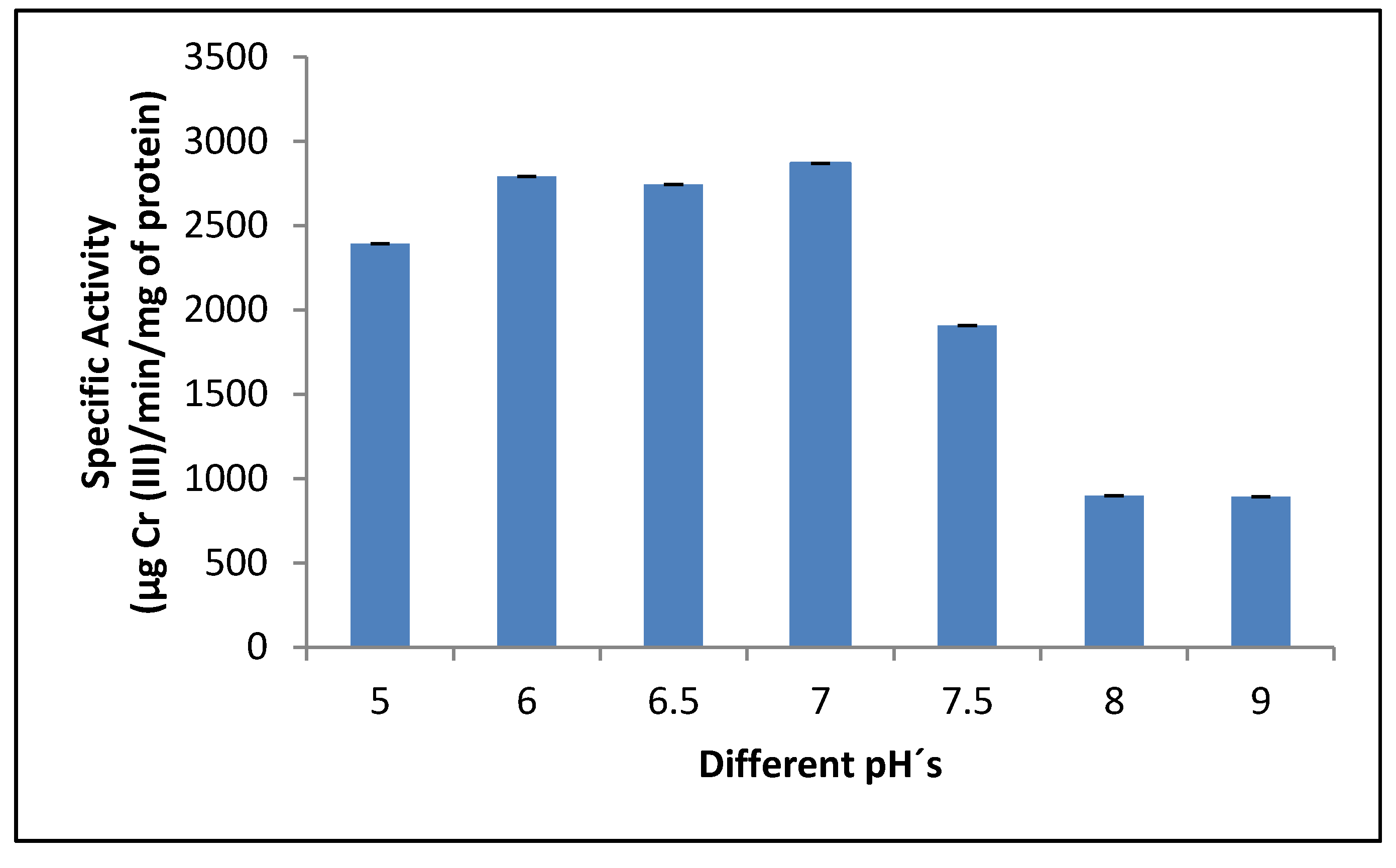
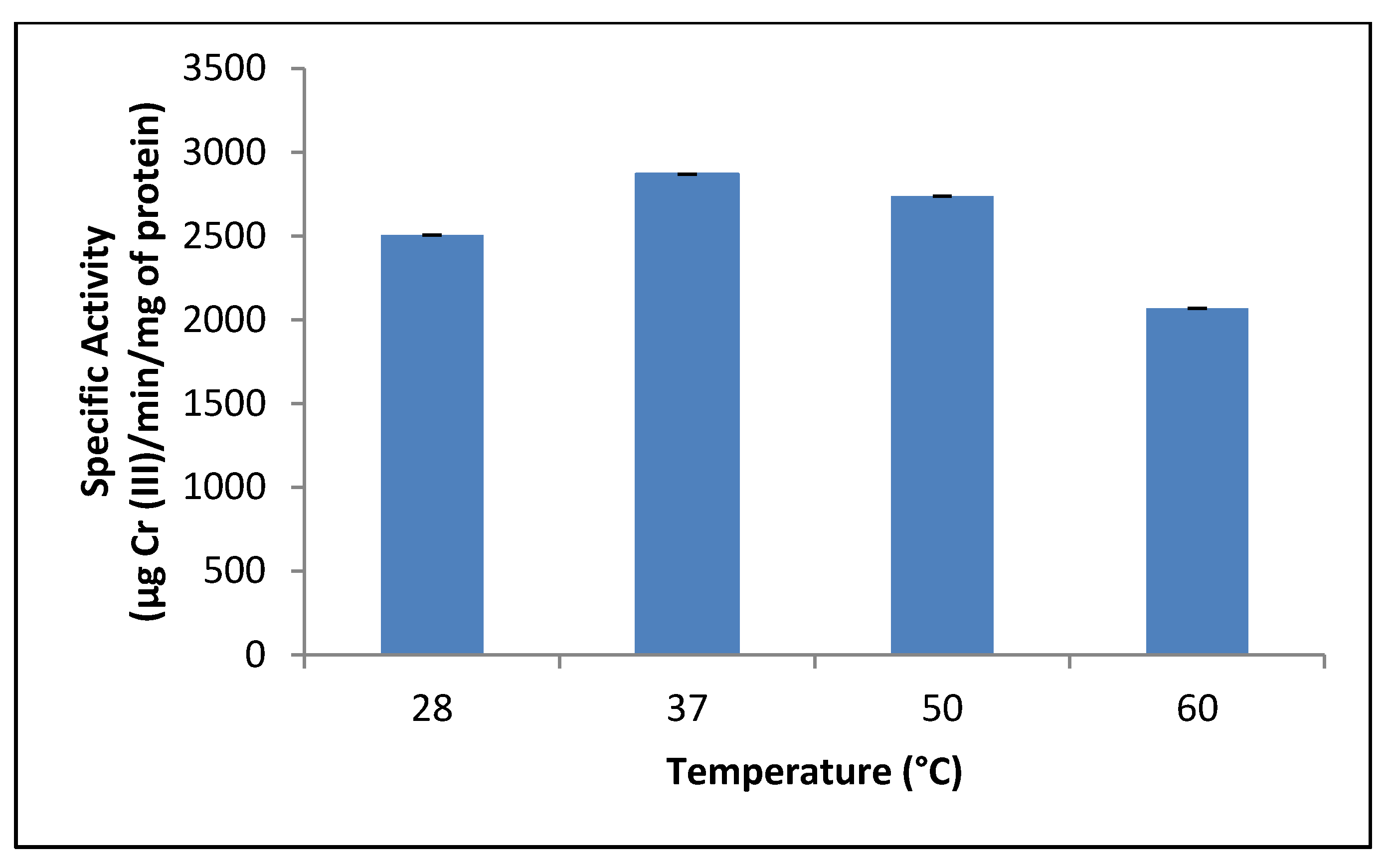
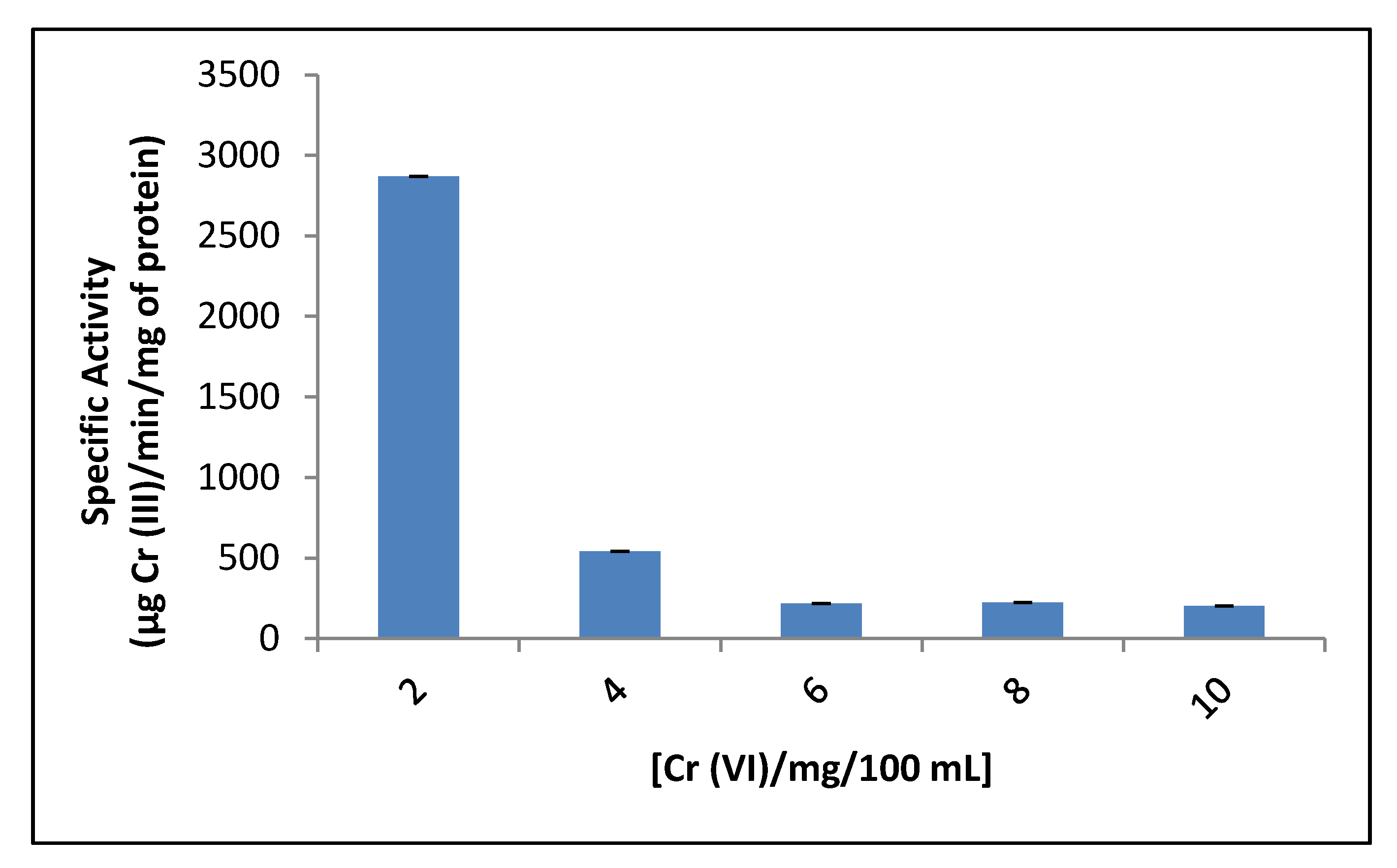
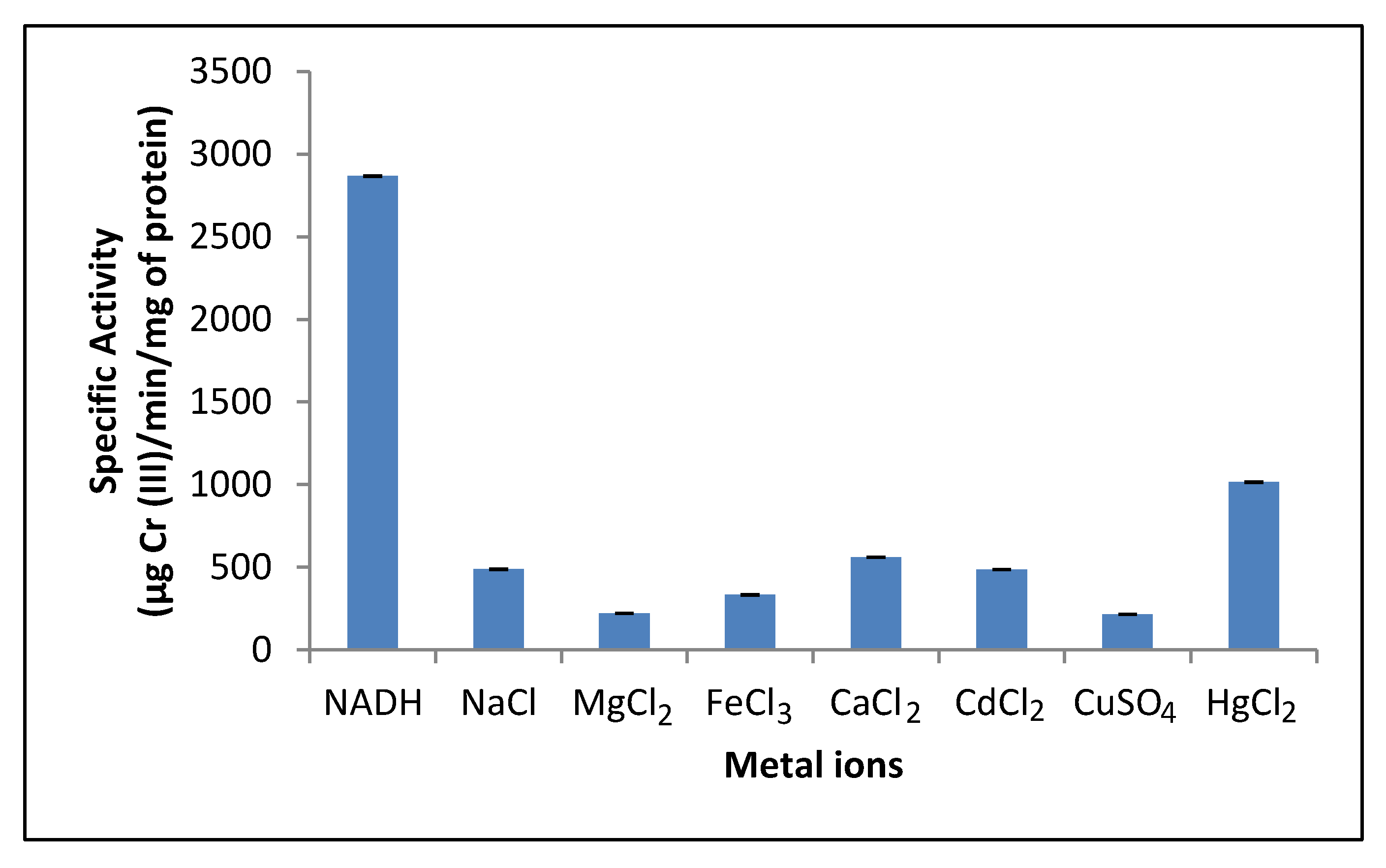
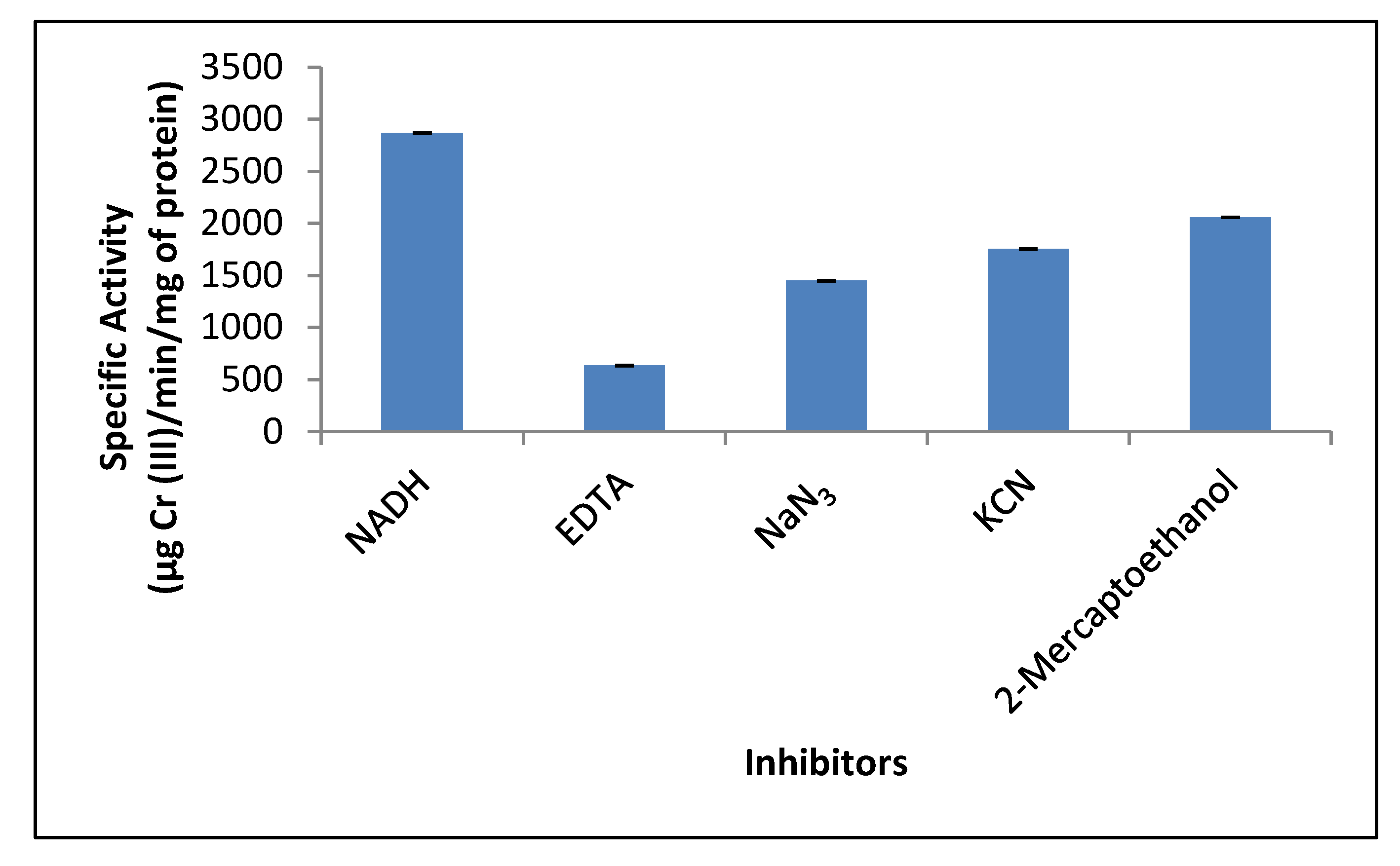
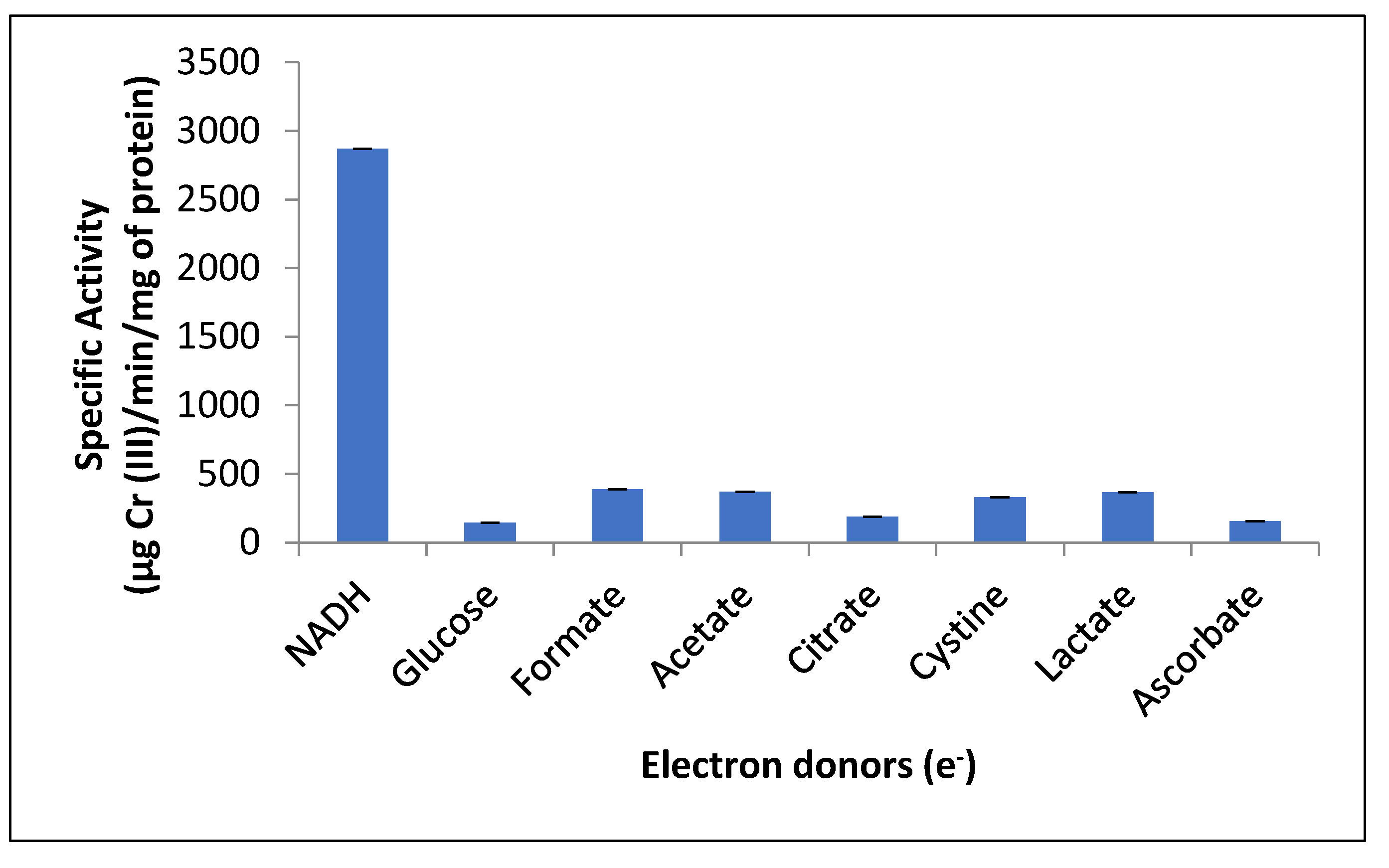
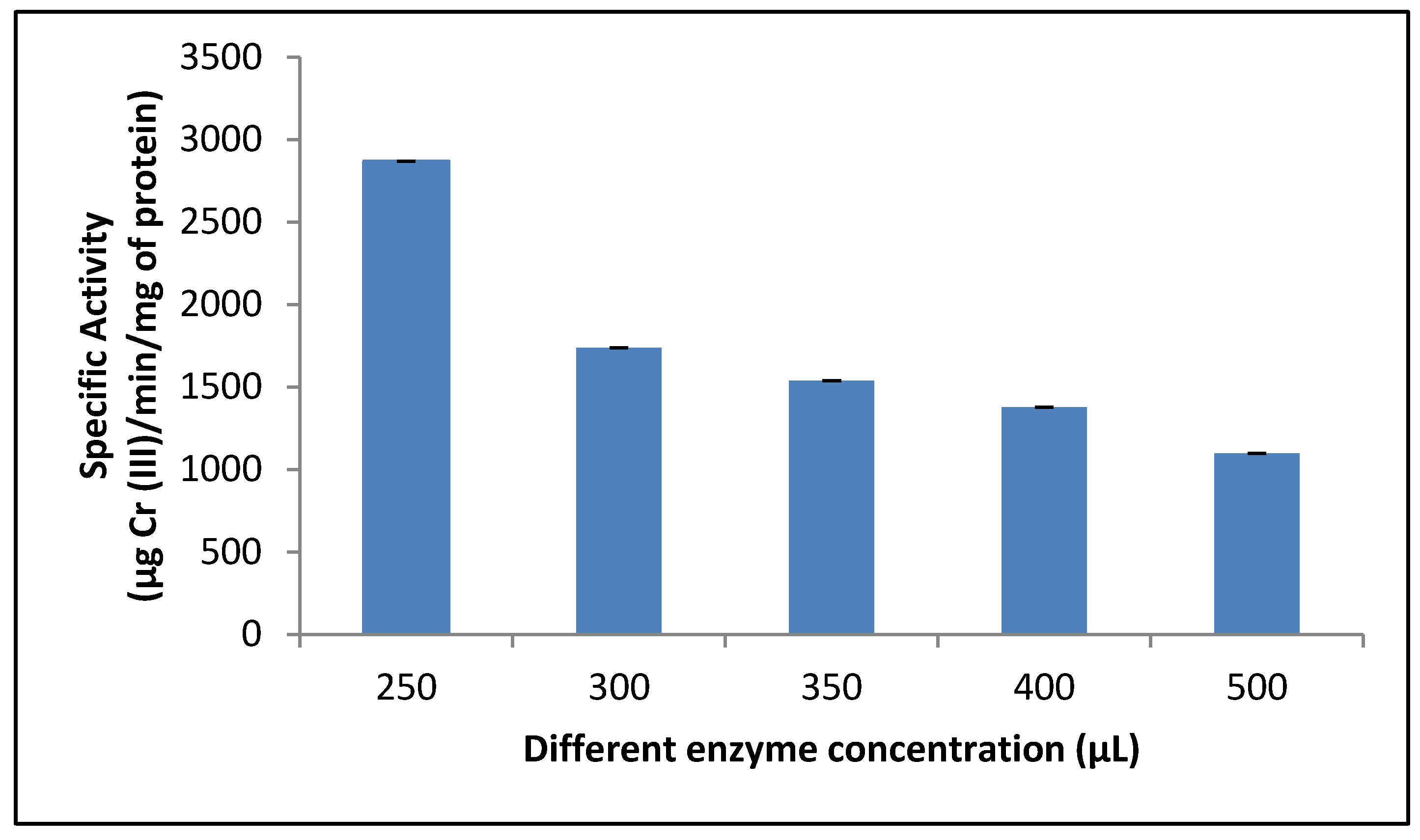

| Microorganisms | Accession Number | Identity (%) |
|---|---|---|
| Purpureocillium lilacinum 001JFC | KR025539 | 100 |
| Paecilomyces lilacinus LTBF 007-1 | GQ229080 | 100 |
| Purpureocillium lilacinum M1447 | KC157713 | 100 |
| Paecilomyces lilacinus SY45B-a | HM242264 | 100 |
| Purpureocillium lilacinum M3905 | KC157751 | 99 |
| Purpureocillium lilacinum M3748 | KC157748 | 99 |
| Purpureocillium lilacinum M3516 | KC157741 | 99 |
| Wave Numbers (cm−1) | ||
|---|---|---|
| Functional Groups before and after Treatment | Cell Fraction Native | Cell Fraction Treated with 20 mg/L |
| O-H stretching vibration from polysaccharides and proteins | 3405.7 | 3410.6 |
| CH3 asymmetric stretching from proteins | 2910.3 | 2922.5 |
| Amide (I) group from protein (C=O) | 1652.1 | 1650.4 |
| Amide (II) group (N-H) + (C-N) from protein | 1540.4 | 1540.4 |
| Amide (III) group (C-N) | 1402.5 | 1360.7 |
| C-O, SO and/or PO stretching vibrations | 1072.7 | 1064.6 |
| Groups CrO4−2 | ------- | 500–900 |
Publisher’s Note: MDPI stays neutral with regard to jurisdictional claims in published maps and institutional affiliations. |
© 2021 by the authors. Licensee MDPI, Basel, Switzerland. This article is an open access article distributed under the terms and conditions of the Creative Commons Attribution (CC BY) license (https://creativecommons.org/licenses/by/4.0/).
Share and Cite
Cárdenas González, J.F.; Acosta Rodríguez, I.; Terán Figueroa, Y.; Lappe Oliveras, P.; Martínez Flores, R.; Rodríguez Pérez, A.S. Biotransformation of Chromium (VI) via a Reductant Activity from the Fungal Strain Purpureocillium lilacinum. J. Fungi 2021, 7, 1022. https://doi.org/10.3390/jof7121022
Cárdenas González JF, Acosta Rodríguez I, Terán Figueroa Y, Lappe Oliveras P, Martínez Flores R, Rodríguez Pérez AS. Biotransformation of Chromium (VI) via a Reductant Activity from the Fungal Strain Purpureocillium lilacinum. Journal of Fungi. 2021; 7(12):1022. https://doi.org/10.3390/jof7121022
Chicago/Turabian StyleCárdenas González, Juan Fernando, Ismael Acosta Rodríguez, Yolanda Terán Figueroa, Patricia Lappe Oliveras, Rebeca Martínez Flores, and Adriana Sarai Rodríguez Pérez. 2021. "Biotransformation of Chromium (VI) via a Reductant Activity from the Fungal Strain Purpureocillium lilacinum" Journal of Fungi 7, no. 12: 1022. https://doi.org/10.3390/jof7121022
APA StyleCárdenas González, J. F., Acosta Rodríguez, I., Terán Figueroa, Y., Lappe Oliveras, P., Martínez Flores, R., & Rodríguez Pérez, A. S. (2021). Biotransformation of Chromium (VI) via a Reductant Activity from the Fungal Strain Purpureocillium lilacinum. Journal of Fungi, 7(12), 1022. https://doi.org/10.3390/jof7121022






